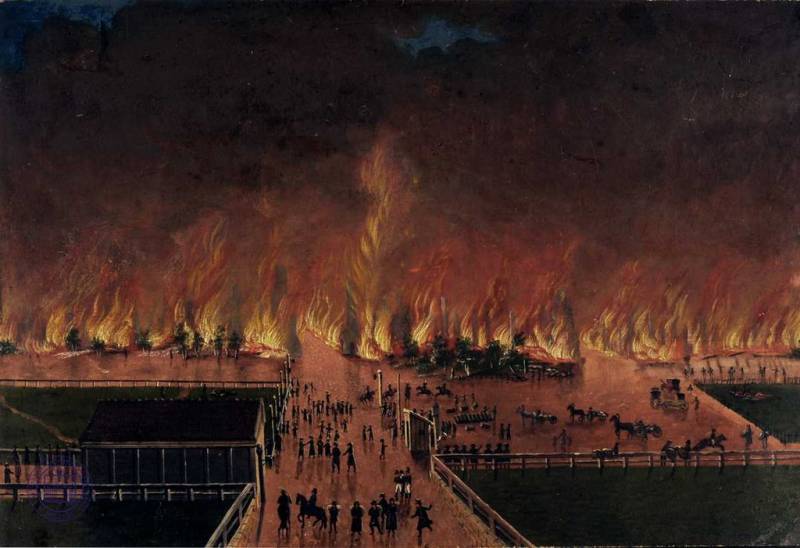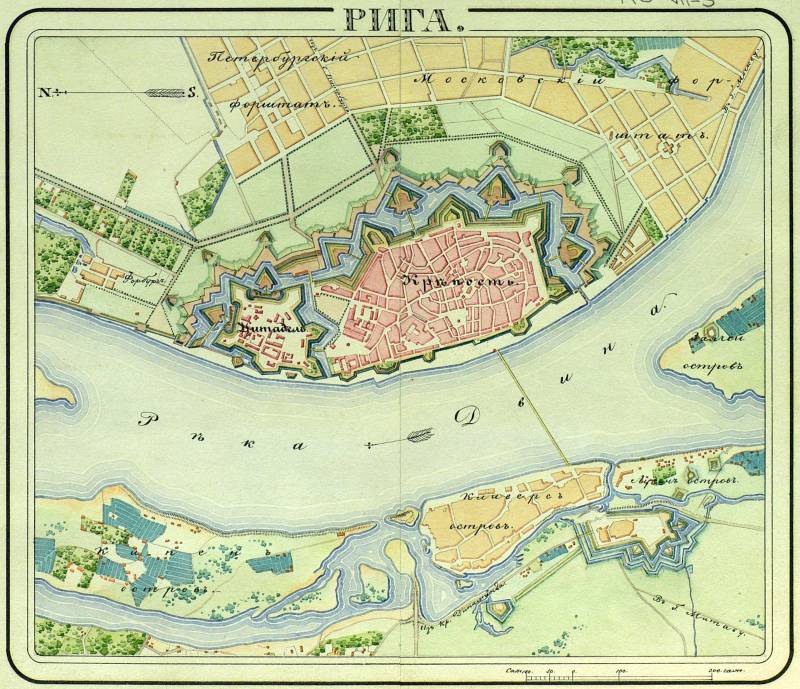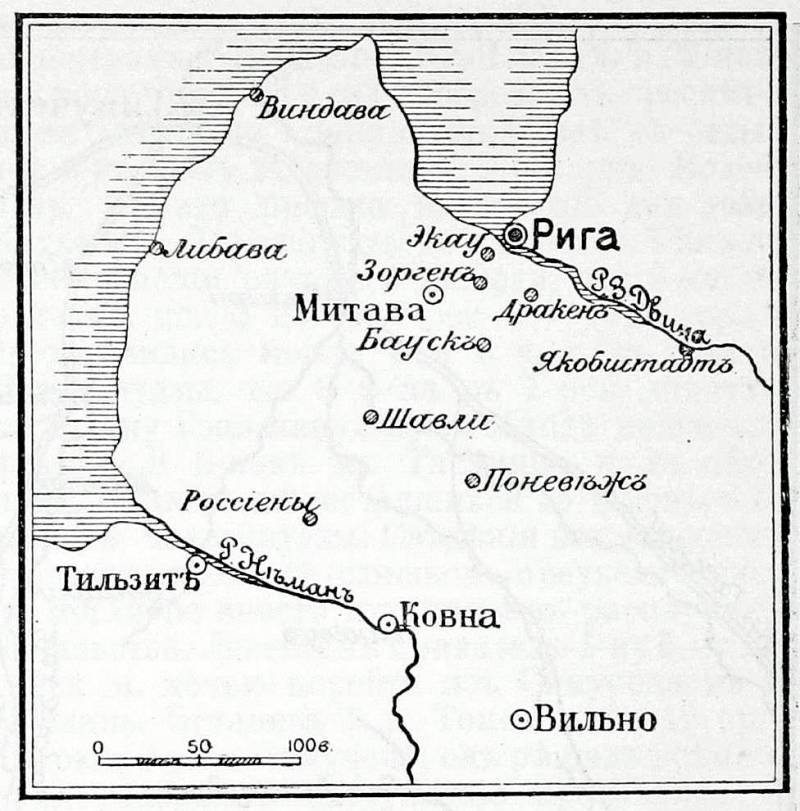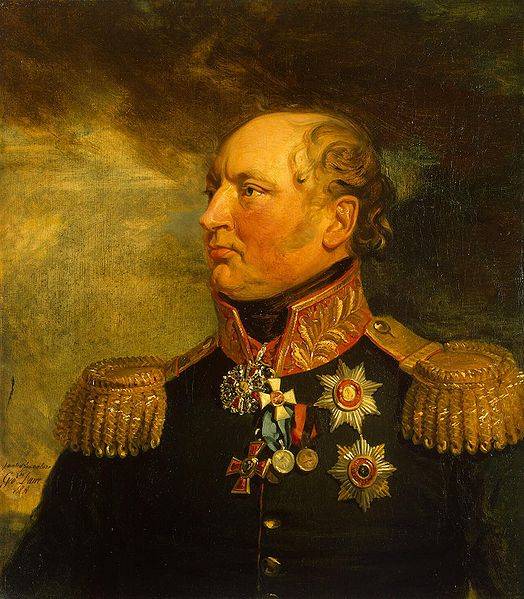Battle of Ekau

Fire in the suburbs of Riga on the night of 11 to 12 (from 23 to 24) July 1812
Riga direction
At the beginning of the campaign of 1812, only the 18-strong garrison of Riga remained on the Dvina, composed mainly of reserve battalions and squadrons, under the command of the Riga military governor Ivan Essen. All the troops in the Riga direction, Courland and Livonia provinces were subordinate to the general.
The Russian command believed that with the outbreak of war, Napoleon would allocate significant forces to capture Riga in order to strengthen his positions in the northern direction, to deprive Russia of an important port through which the Russians could contact the British. Therefore, before the war, the defense of Riga and Dyunamunde (Dinamunde) was strengthened as much as possible.
By 1812, the Riga fortifications included the Main Fortress (9 bastions and 1 semi-bastion) on the right bank of the Western Dvina, the Citadel (a bastion-type fortification with 6 bastions) adjacent to it downstream, and the Koberschanz bridgehead on the other bank (included a bastion, two half-bastion, three ravelins and a redoubt). The main fortress and the Citadel were surrounded by wide moats. Riga was defended from the sea by the Dünamünd Fortress (since 1893, the Daugavgriva Fortress), located on an island at the mouth of the river, 14 kilometers northwest of Riga.
All the fortifications were built by the Swedes in the 1811th-XNUMXth centuries. In XNUMX, measures were taken to bring the Riga fortress to combat readiness. Engineer Colonel Ivan Trusson (Truzson) and Major General Lev Yashvil were sent to Riga.
Under the leadership of Trousson, work was carried out to restore the collapsed fortifications, new positions and batteries were built. The main attention was focused on strengthening the Zadvinsk fortifications. Kobershanets was reinforced with double palisades. They built new batteries on Luken Island behind the left flank of Kobershantz and the Great Anbar Battery on Cleavers Island behind the right flank. An earthen redoubt and a battery were set up on Hare Island. But they did not manage to build everything that they planned.
The fortress was also prepared for a siege: gunpowder stored outside the city was taken to the Citadel; stocks of flour from the outskirts (suburbs) are transferred to the fortress, provisions are brought in, cattle and horses are driven from the Courland and Livonia provinces. Several churches were turned into food warehouses. The townspeople were instructed to create a 4-month supply of food. Fire fighting measures were taken. In particular, combustible materials were taken out of the city. The owners of the houses had to stock up on barrels of water, a tool for extinguishing fires.
At the same time, all the valuables that they could were taken out of Courland. From Libava and Mindava they export tools and grain. Everything that could not be taken out was destroyed. Carts and especially wheels are broken, giving out receipts to the owners. They destroy bridges, spoil roads in order to impair the ability of the enemy army to march quickly.

Riga fortress in the album 1831
The beginning of hostilities
With the beginning of the war, a British detachment arrived in Riga. fleet as part of the ships "Aboukir", "Ariel" and "Renard" under the command of Rear Admiral Thomas Martin. The construction of gunboats began, on which the British also served.
After the main forces of Napoleon crossed the Dvina, there was a lull in the Riga direction for the first time. Napoleon ordered the commander of the 30th 10th Corps, Etienne Jacques MacDonald, to take Riga. The corps consisted of the Prussian Auxiliary Corps of General von Gravert (2 divisions, Prussian light cavalry) and the French 7th Infantry Division of General Granjean. Due to the successful actions of Wittgenstein's corps against Oudinot, MacDonald's troops lingered on the Dvina longer than the French emperor had planned. Gravert's troops marched from Shavli.
At the same time, Essen sent Major General Velyaminov from Riga to Mitava to monitor Bauska and the border of the Vilna province. Russian patrols reached Shavli, where on June 23 (July 5), 1812, the first skirmish took place. Our retreated to Janishek, where on June 24 a new clash occurred. Velyaminov set out from Mitava with 5 battalions. The detachment was transferred under the command of Lieutenant General Fyodor Leviz. The new commander decided not to take risks and withdraw the troops to Ekau.

theater of war. "Military Encyclopedia" by Ivan Sytin. St. Petersburg; 1912
Battle of Ekau
The Prussians advanced slowly and only on July 7 (19), 1812 approached Ekau. The Russian detachment consisted of 3-4 thousand soldiers with 10 guns. The Prussians had about 7 thousand with 32 guns.
Gravert launched the attack from the front with an artillery skirmish, then sent the cavalry to attack. The general himself in this battle fell off his horse and broke his leg, handed over command of the Prussian troops to Lieutenant General York and went to Germany for treatment. At the same time, the Kleist detachment, which was located to the east, was supposed to bypass the Russians from the flank and rear.
Leviz's detachment fought back in houses, behind fences and church walls. Until the evening, our troops successfully repelled enemy attacks, then the Prussians captured the bridge and created a bridgehead on the right bank of the river. Ekau. Kleist hit the Russian left flank and broke through to Ekau. The Prussians were able to crush two Russian battalions. Late in the evening, Levis organized a counterattack, but was not successful. Under pressure from superior enemy forces, our troops retreated. Leviz's infantry with bayonets paved the way through the Prussian cavalry. The Russians retreated to Riga.
The Battle of Ekau was the first clash between Russian and Prussian troops since the Seven Years' War. The Prussians fought bravely. Napoleon awarded many Prussian officers the Order of the Legion of Honor in order to bring new allies closer.
As a result, Russian troops cleared the left bank of the Dvina. Essen ordered to burn the Mitav suburb of Riga. Due to strong winds, the fire became uncontrollable and thousands of citizens were left without shelter and property.

Portrait of Lieutenant General Fedor Fedorovich Leviz (1767–1824) by George Dawe. Military gallery of the Winter Palace
Information